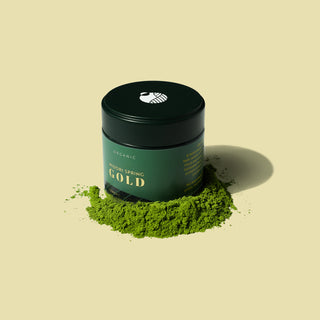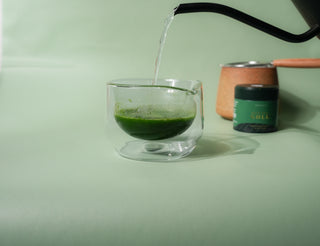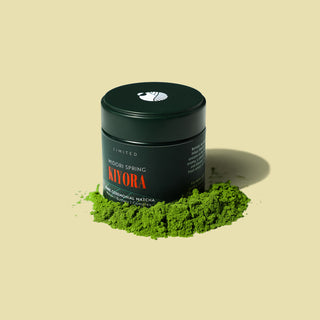Great-tasting Matcha does not happen by accident. If only it did—right? —but since it doesn't, it would be good to take some time to understand the basics. Thankfully, unlike the rudiments of Calculus, you should be able to get up to speed with Matcha in just a few moments.
Let's dive into how tasting things work first.
Basics of Taste
Matcha and its different ways of making it comprise multiple converging factors that produce a range of potential tastes. When tasting Matcha (like wine or coffee), start by smelling it and try picking up aroma notes. Then sip your Matcha slowly and savour the full range of flavors. When you do so, you want to slurp to cover your tongue and entire palate (you want it to cover every area of your tongue since certain taste receptors group together in different areas of the tongue. Don't be afraid to make a slurpy noise!
To truly describe the flavor and the difference of high quality Matcha, you'll need to know a bit more about how human taste works.
The Five 'Tastes'
There are five basic tastes: sweet, sour, salty, bitter, and umami. Each type of taste receptor on our tongues is sensitive to a different type of flavor.
When we drink Matcha, for instance, the molecules in the drink bind to the taste receptors on our tongue. This sends signals to the brain, which interprets the signal as a taste.
Additional Factors on Taste
Aside from the particular molecules in a drink or food, the taste can be affected by the temperature of the drink/food, the texture of the drink/food, and the combinations of other flavors within the drink/food itself. These all become very important when diving headlong into the world of matcha-making.
You can start to appreciate why sommeliers exist in almost every drink category (wine, coffee, and even olive oil! ). Taste is complex and is best enjoyed when you can pay careful credence to how it works.
Terroir
Terroir is the essence of a region's landscape, climate, and soil and how it can impact the taste of wine. At Midori Spring, we believe in the power of terroir when it comes to crafting the perfect Matcha. That's why we source from various regions with unique landscapes and origins, providing a personal touch to our taste selections. We don't settle for mass-produced Matcha - instead, we carefully refine, source, and search for each tea leaf from small independent farms across various prefectures to provide a unique and bold taste you won't find anywhere else.

Amino Acids
Matcha tends to have much higher quantities of amino acids compared with other types of tea (Birch). This is the source of so many of Matcha's health benefits but is also what parades its many exciting tastes.
Matcha (especially quality Matcha) contains many types of amino acids (Ye). These include L-Amino Acids, which sometimes can be characterized as sometimes sweet or bitter (both potential tastes in Matcha (Solms). It also includes D-Amino Acids, which are primarily considered sweet (Solms). Who knew chemistry tasted so good?
What Does Matcha Taste Like?
We've covered how taste works and different types of taste. But Matcha is a very particular drink that majors on only a few types of tastes while other tastes aren't so important for it. To fully explore the uniqueness of Matcha and its differences based on terroir, you'll want to know its main descriptors.
Here are the main ways of describing Matcha's taste:
Vegetal
Vegetal is a term used to describe plant-y tastes. It's not one of the five basic tastes (sweet, sour, salty, bitter, and umami), but it is a common flavor in many foods—especially for Matcha.
Vegetal flavors are often described as being green, grassy, or sometimes earthy—tastes afforded by the chlorophyll in plant leaves (Ošťádalová). Green teas (and others) have the same taste, but because Matcha uses whole tea leaves (minus the veins and stems), it makes its vegetal taste very prominent. This taste combines with the sweet and umami tastes, which come out with particular types of preparation methods. For more on that, see the difference between umami and sweet matcha preparation.
Sweet
The taste of sweetness is a basic taste that is often associated with the presence of sugar. However, some things can taste sweet even if they do not contain sugar. As detailed above, amino acids can often be associated with sweetness. How we prepare Matcha can have a large effect on how we experience this—such as quickly frothing the Matcha and pairing it with milk.
You can check out our guide on how to bring out the sweet taste of Matcha
Here's a full guide on how to bring out the sweet taste of your Matcha.
Umami
Umami is a pleasant, savory taste. The same sort of taste is found in broths. Matcha contains glutamate (the amino acid found most in Matcha), which is umami/savory in Matcha and, in other situations, sour (Birch).
By noticing each of these individually and then seeing how they work together, you'll be in a good place to discern good quality matcha. Quality Matcha means multiple things.
Midori Spring proudly sources the best Matcha from the best-growing regions and farms. We do not source from large-scale production mills focusing on quantity rather than true quality. We source based on taste and taste alone.
Bitter
Bitterness is a badge of honor in Matcha, thanks to its high concentration of catechins - a type of antioxidant found in tea. But the bitterness can be a bit too much for newbies or those with a sweet tooth. Fear not, matcha lovers! There are ways to balance the bitterness and bring out the sweeter, savory flavors.
First things first, opt for high-quality matcha powder that's been made using the shade-grown method. This top-notch powder usually has a smoother, less bitter taste than its cheaper counterparts. Then, get creative with your brewing techniques! Try using cooler water and whisking your Matcha more gently to prevent over-extraction and bitterness. Who knew that the secret to perfect Matcha was a little bit of finesse and a lot of experimentation?
How much caffeine does Matcha have?
Matcha's production process increases the production of amino acids, like L-theanine, and reduces caffeine production. So, while Matcha has less caffeine than a cup of coffee, it still packs more punch than regular green tea.
On average, a cup of Matcha contains about 70mg of caffeine, less than the 95mg in a standard coffee cup. But don't let that fool you! The caffeine in Matcha is like a stealth ninja, releasing its energy slowly and steadily thanks to the L-theanine's calming effects. So you won't be bouncing off the walls like a hyperactive kangaroo.
But wait, there's more! The exact amount of caffeine in Matcha can vary based on the quality of the tea leaves, how it's prepared, and how much you drink. So, if you're caffeine-sensitive, take it slow and steady. Start with a small serving and see how your body reacts before downing a gallon of Matcha like its water.
What are the benefits of drinking Matcha?
Matcha has become a health and flavor superstar in recent years. Here are some ways Matcha can benefit your health:
- Antioxidant overload: Matcha has lots of antioxidants, particularly catechins. These little superheroes can help protect your body from damage caused by free radicals. One catechin in particular, EGCG (epigallocatechin gallate), is like the Iron Man of antioxidants.
- Brain booster: Matcha contains caffeine and L-theanine, a dynamic duo that work together to improve brain function. Caffeine provides energy and alertness, while L-theanine brings Zen vibes, improving cognitive performance.
- Weight-loss wonder: Matcha may help speed up your metabolism and promote fat burning, making it a potential aid for weight loss. Plus, it may help reduce inflammation, which can be a sneaky culprit behind obesity and other health problems.
- Heart helper: Matcha could be a heart-healthy choice, as it may lower blood pressure, reduce cholesterol levels, and protect the heart from oxidative stress and inflammation.
- Immune system support: Matcha contains compounds that could boost your immune function, helping to keep you healthy and protected from infections and diseases. It's like a secret agent for your immune system!
So, if you want to boost your health and enjoy a delicious and unique flavor, try Matcha! And don't forget to check out our comprehensive list of all the amazing health benefits of drinking Matcha.

Conclusion
You should be well on your way to impressing friends about the aesthetic pleasures of Matcha as you casually drop references to how chemistry affects taste. But, more importantly, you can more accurately describe what you are enjoying when you make a cup of Matcha. Being able to describe Matcha is the first step in preparing it better and discerning the quality of different Matcha for yourself.
You've now taken your first major step in that wonderful direction. But that is hardly all you can study up on. It might pique even more interest of yours to study the differences between culinary and ceremonial grade matcha, we talked about their in-depth differences which can be helpful to help you decide which kind of Matcha suits you best.
If you are really into this stuff, feel free to join the Midori Spring Ambassador program, where you can talk about delicious Matcha and reap some sweet, sweet benefits.
References
- Birch, L. L., & McPhee, L. (1989). Amino acids and taste in humans: A review. Food Quality and Preference, 2(3-4), 153-162.
- Ošťádalová, M., Tremlová, B., Pokorná, J., & Král, M. (2017). Chlorophyll as an indicator of green tea quality. Food Chemistry, 221, 197-202.
- Solms, J., Vuataz, L., & Egli, R. H. (1965). The taste of L- and D-amino acids. Experientia, 21(12), 692-4.
- Ye, Y., Yan, J., Cui, J., Mao, S., Li, M., Liao, X., & Tong, H. (2018). Dynamic changes in amino acids, catechins, caffeine and gallic acid in green tea during withering. Journal of Food Composition and Analysis, 66, 98-108.


















